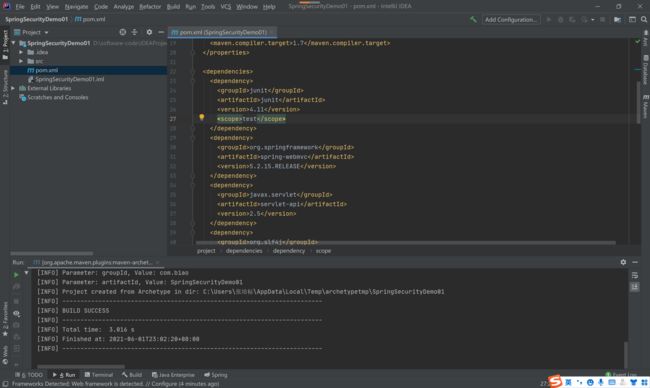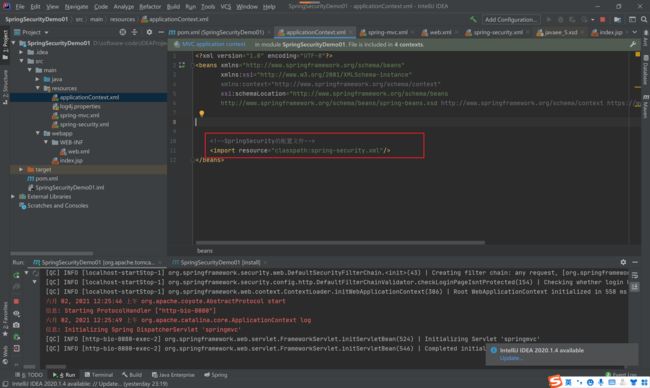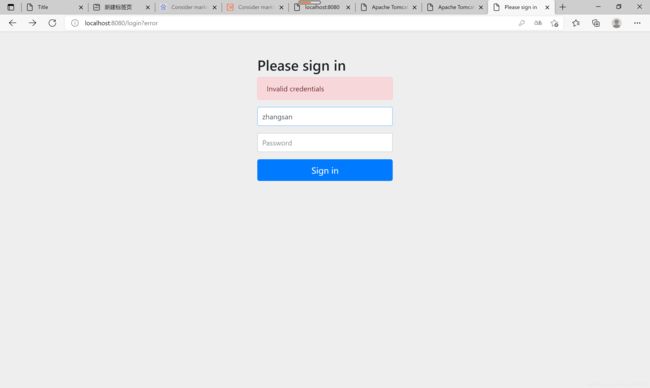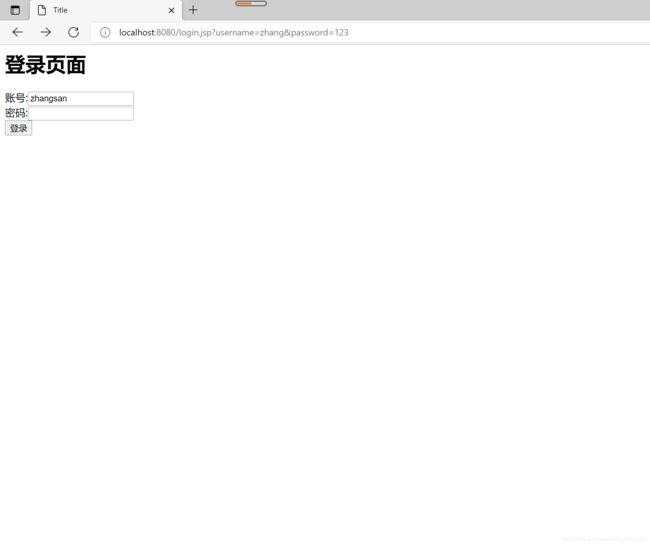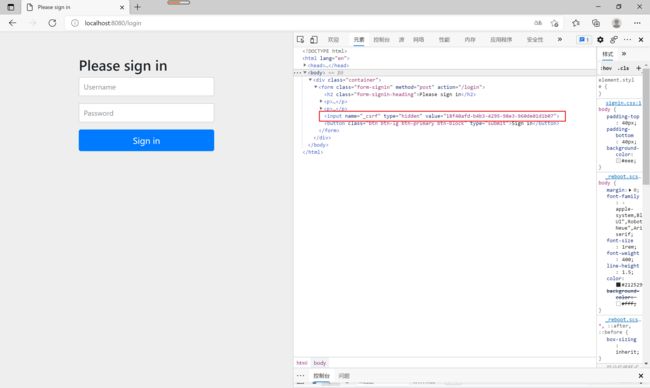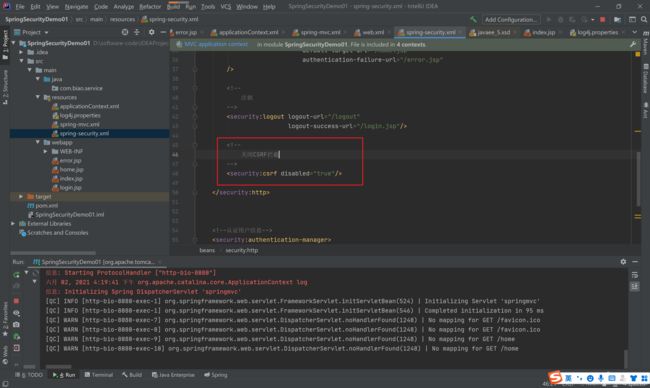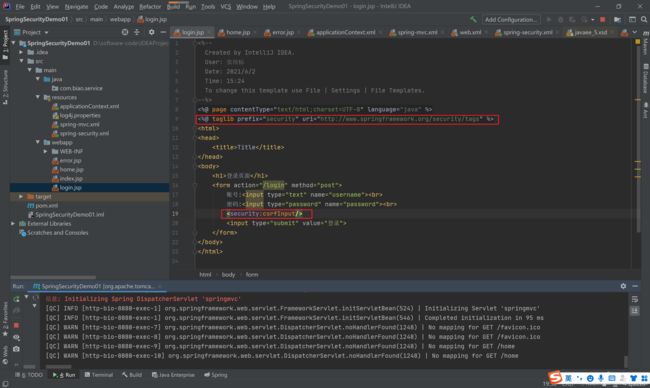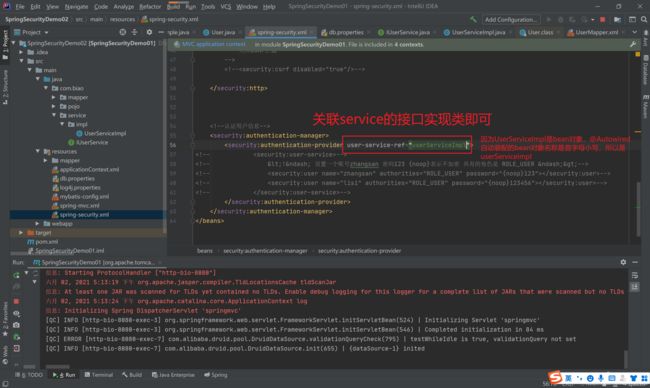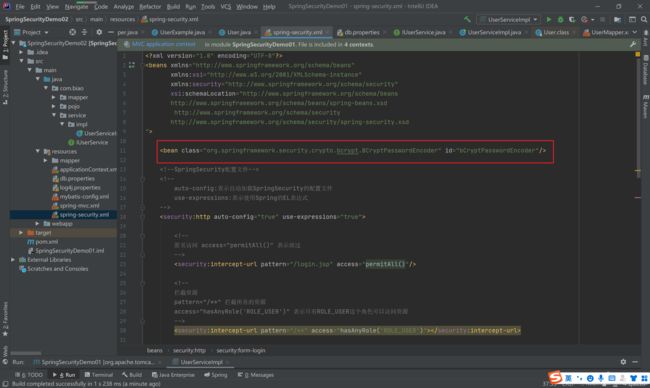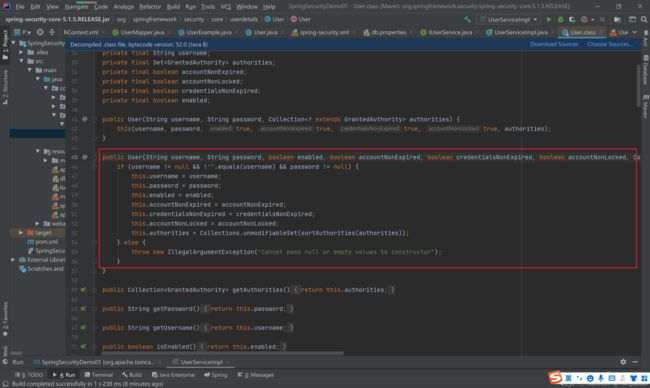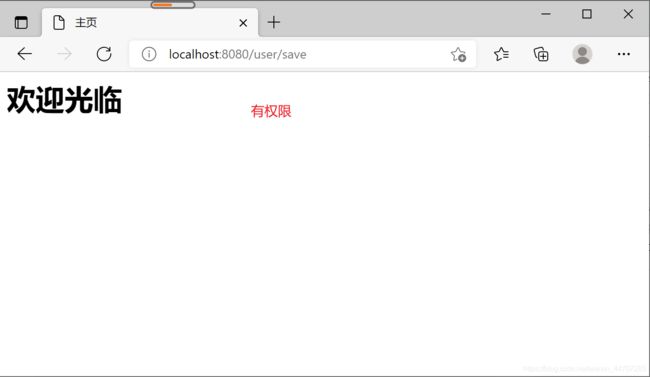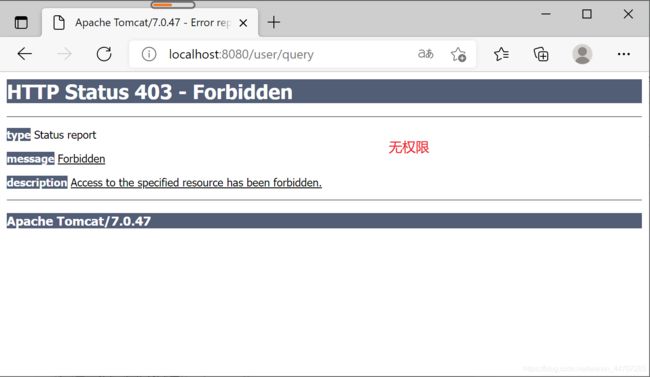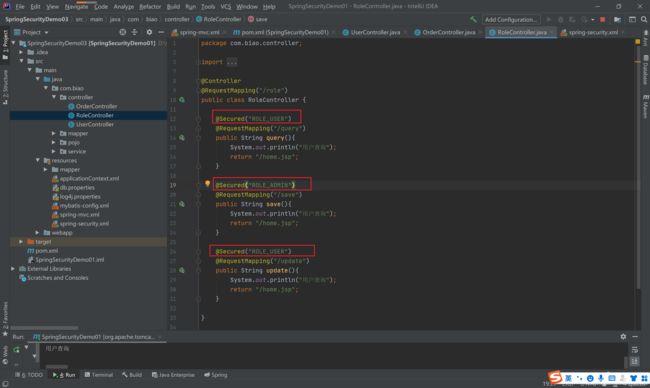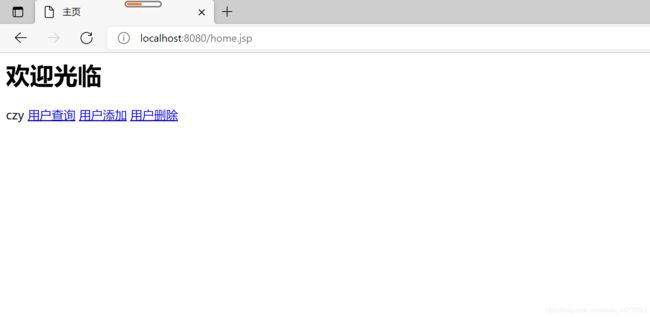01.SpringSecurity基础应用——概念、整合SpringSecurity、自定义登录页面、数据库验证、Remember me、授权操作
一、SpringSecurity概念
SpringSecurity是Spring采用AOP思想,基于servlet过滤器实现的安全框架。它提供了完善的认证机制和方法级的授权功能。是一款非常优秀的权限管理框架。
SpringSecurity是一个功能强大且高度可定制的身份验证和访问控制框架。它是用于保护基于Spring的应用程序的事实上的标准。
SpringSecurity是一个框架,致力于为Java应用程序提供身份验证和授权。像所有Spring项目一样,SpringSecurity的真正强大支出在于它轻松扩展以满足定制需求的能力。
特征:
- 对身份验证和授权的全面且可扩展的支持
- 包括免受会话固定,点击劫持,跨站点请求伪造等攻击
- servlet Api 集成
- 与Spring Web MVC的可选集成
二、入门案例
1.环境准备
我们准备一个SpringMVC+Spring+jsp的Web环境
1.1 创建Web项目
1.2 导入依赖
<dependency>
<groupId>junitgroupId>
<artifactId>junitartifactId>
<version>4.11version>
<scope>testscope>
dependency>
<dependency>
<groupId>org.springframeworkgroupId>
<artifactId>spring-webmvcartifactId>
<version>5.1.6.RELEASEversion>
dependency>
<dependency>
<groupId>javax.servletgroupId>
<artifactId>servlet-apiartifactId>
<scope>providedscope>
<version>2.5version>
dependency>
<dependency>
<groupId>org.slf4jgroupId>
<artifactId>slf4j-log4j12artifactId>
<version>1.7.28version>
dependency>
配置Tomcat
<plugins>
<plugin>
<groupId>org.apache.tomcat.mavengroupId>
<artifactId>tomcat7-maven-pluginartifactId>
<version>2.2version>
<configuration>
<port>8080port>
<path>/path>
<uriEncoding>utf-8uriEncoding>
configuration>
plugin>
plugins>
1.3 添加相关的配置文件
1.3.1 applicationContext.xml
<beans xmlns="http://www.springframework.org/schema/beans"
xmlns:xsi="http://www.w3.org/2001/XMLSchema-instance"
xsi:schemaLocation="http://www.springframework.org/schema/beans
http://www.springframework.org/schema/beans/spring-beans.xsd">
beans>
1.3.2 spring-mvc.xml
<beans xmlns="http://www.springframework.org/schema/beans"
xmlns:xsi="http://www.w3.org/2001/XMLSchema-instance"
xsi:schemaLocation="http://www.springframework.org/schema/beans
http://www.springframework.org/schema/beans/spring-beans.xsd">
beans>
1.3.3 log4j.properties
log4j.rootCategory=INFO, stdout , R
log4j.appender.stdout=org.apache.log4j.ConsoleAppender
log4j.appender.stdout.layout=org.apache.log4j.PatternLayout
log4j.appender.stdout.layout.ConversionPattern=[QC] %p [%t] %C.%M(%L) | %m%n
1.3.4 web.xml
DOCTYPE web-app PUBLIC
"-//Sun Microsystems, Inc.//DTD Web Application 2.3//EN"
"http://java.sun.com/dtd/web-app_2_3.dtd" >
<web-app version="2.5"
xmlns="http://java.sun.com/xml/ns/javaee"
xmlns:xsi="http://www.w3.org/2001/XMLSchema-instance"
xsi:schemaLocation="http://java.sun.com/xml/ns/javaee
http://java.sun.com/xml/ns/javaee/web-app_2_5.xsd">
<display-name>Archetype Created Web Applicationdisplay-name>
<context-param>
<param-name>contextConfigLocationparam-name>
<param-value>classpath:applicationContext.xmlparam-value>
context-param>
<listener>
<listener-class>org.springframework.web.context.ContextLoaderListenerlistener-class>
listener>
<servlet>
<servlet-name>springmvcservlet-name>
<servlet-class>org.springframework.web.servlet.DispatcherServletservlet-class>
<init-param>
<param-name>contextConfigLocationparam-name>
<param-value>classpath:spring-mvc.xmlparam-value>
init-param>
servlet>
<servlet-mapping>
<servlet-name>springmvcservlet-name>
<url-pattern>/url-pattern>
servlet-mapping>
<filter>
<filter-name>encodingFilterfilter-name>
<filter-class>org.springframework.web.filter.CharacterEncodingFilterfilter-class>
<init-param>
<param-name>encodingparam-name>
<param-value>UTF-8param-value>
init-param>
<init-param>
<param-name>forceRequestEncodingparam-name>
<param-value>trueparam-value>
init-param>
<init-param>
<param-name>forceResponseEncodingparam-name>
<param-value>trueparam-value>
init-param>
filter>
<filter-mapping>
<filter-name>encodingFilterfilter-name>
<url-pattern>/*url-pattern>
filter-mapping>
<servlet-mapping>
<servlet-name>defaultservlet-name>
<url-pattern>*.htmlurl-pattern>
servlet-mapping>
<servlet-mapping>
<servlet-name>defaultservlet-name>
<url-pattern>*.cssurl-pattern>
servlet-mapping>
<servlet-mapping>
<servlet-name>defaultservlet-name>
<url-pattern>*.jsurl-pattern>
servlet-mapping>
<servlet-mapping>
<servlet-name>defaultservlet-name>
<url-pattern>*.jpgurl-pattern>
servlet-mapping>
<servlet-mapping>
<servlet-name>defaultservlet-name>
<url-pattern>*.pngurl-pattern>
servlet-mapping>
web-app>
2.整合SpringSecurity
2.1 添加相关的依赖
| 依赖 | 说明 |
|---|---|
| spring-security-core.jar | 核心包,然和SpringSecurity的功能都需要此包 |
| spring-security-web.jar | web工程必备,包含过滤器和相关的web安全的基础结构代码 |
| spring-security-config.jar | 用于xml文件解析处理 |
| spring-security-tablibs.jar | 动态标签库 |
<dependency>
<groupId>org.springframework.securitygroupId>
<artifactId>spring-security-configartifactId>
<version>5.1.5.RELEASEversion>
dependency>
<dependency>
<groupId>org.springframework.securitygroupId>
<artifactId>spring-security-taglibsartifactId>
<version>5.1.5.RELEASEversion>
dependency>
2.2 web.xml配置文件中配置SpringSecurity
<filter>
<filter-name>springSecurityFilterChainfilter-name>
<filter-class>org.springframework.web.filter.DelegatingFilterProxyfilter-class>
filter>
<filter-mapping>
<filter-name>springSecurityFilterChainfilter-name>
<url-pattern>/*url-pattern>
filter-mapping>
2.3 添加SpringSecurity的配置文件
2.4 测试
3.自定义登录页面
3.1 登录页面
<%@ page contentType="text/html;charset=UTF-8" language="java" %>
<html>
<head>
<title>Titletitle>
head>
<body>
<h1>登录页面h1>
<form action="/login" method="post">
账号:<input type="text" name="username"><br>
密码:<input type="password" name="password"><br>
<input type="submit" value="登录">
form>
body>
html>
3.2 配置文件配置认证的信息
<beans xmlns="http://www.springframework.org/schema/beans"
xmlns:xsi="http://www.w3.org/2001/XMLSchema-instance"
xmlns:security="http://www.springframework.org/schema/security"
xsi:schemaLocation="http://www.springframework.org/schema/beans
http://www.springframework.org/schema/beans/spring-beans.xsd
http://www.springframework.org/schema/security
http://www.springframework.org/schema/security/spring-security.xsd
">
<security:http auto-config="true" use-expressions="true">
<security:intercept-url pattern="/login.jsp" access="permitAll()"/>
<security:intercept-url pattern="/**" access="hasAnyRole('ROLE_USER')">security:intercept-url>
<security:form-login login-page="/login.jsp"
login-processing-url="/login"
default-target-url="/home.jsp"
authentication-failure-url="/error.jsp"
/>
<security:logout logout-url="/logout"
logout-success-url="/login.jsp"/>
security:http>
<security:authentication-manager>
<security:authentication-provider>
<security:user-service>
<security:user name="zhangsan" authorities="ROLE_USER" password="{noop}123">security:user>
<security:user name="lisi" authorities="ROLE_USER" password="{noop}123456">security:user>
security:user-service>
security:authentication-provider>
security:authentication-manager>
beans>
3.3 测试
3.4 提交会出现403错误
3.4.1 CSRF拦截
3.5 解决403错误方法
3.5.1 方法一
3.5.2 方法二
4.数据库认证
4.1 引入相关依赖
<dependency>
<groupId>org.mybatisgroupId>
<artifactId>mybatisartifactId>
<version>3.5.4version>
dependency>
<dependency>
<groupId>org.mybatisgroupId>
<artifactId>mybatis-springartifactId>
<version>2.0.4version>
dependency>
<dependency>
<groupId>mysqlgroupId>
<artifactId>mysql-connector-javaartifactId>
<version>8.0.17version>
dependency>
<dependency>
<groupId>com.alibabagroupId>
<artifactId>druidartifactId>
<version>1.0.9version>
dependency>
4.2 创建db.properties
jdbc.driver=com.mysql.cj.jdbc.Driver
jdbc.url=jdbc:mysql://localhost:3306/logistics?useUnicode=true&characterEncoding=UTF-8&serverTimezone=UTC
jdbc.username=root
jdbc.password=123456
4.3 在applicationContext.xml配置
<beans xmlns="http://www.springframework.org/schema/beans"
xmlns:xsi="http://www.w3.org/2001/XMLSchema-instance"
xmlns:context="http://www.springframework.org/schema/context"
xsi:schemaLocation="http://www.springframework.org/schema/beans
http://www.springframework.org/schema/beans/spring-beans.xsd http://www.springframework.org/schema/context https://www.springframework.org/schema/context/spring-context.xsd">
<context:component-scan base-package="com.biao.service" >context:component-scan>
<import resource="classpath:spring-security.xml"/>
<context:property-placeholder location="classpath:db.properties"/>
<bean class="com.alibaba.druid.pool.DruidDataSource" id="dataSource">
<property name="url" value="${jdbc.url}"/>
<property name="driverClassName" value="${jdbc.driver}"/>
<property name="username" value="${jdbc.username}"/>
<property name="password" value="${jdbc.password}"/>
bean>
<bean class="org.mybatis.spring.SqlSessionFactoryBean" id="sessionFactoryBean">
<property name="dataSource" ref="dataSource"/>
<property name="configLocation" value="classpath:mybatis-config.xml"/>
<property name="mapperLocations" value="classpath:mapper/*.xml"/>
bean>
<bean class="org.mybatis.spring.mapper.MapperScannerConfigurer">
<property name="basePackage" value="com.biao.mapper"/>
bean>
beans>
4.4 需要完成认证的Service中继承UserDetailService父接口
package com.biao.service;
import org.springframework.security.core.userdetails.UserDetailsService;
/**
* 要实现数据库验证
* 我们自定义的Service需要继承UserDetailsService接口
*/
public interface IUserService extends UserDetailsService {
}
4.5 实现类中实现验证方法
package com.biao.service.impl;
import com.biao.mapper.UserMapper;
import com.biao.pojo.User;
import com.biao.pojo.UserExample;
import com.biao.service.IUserService;
import org.springframework.beans.factory.annotation.Autowired;
import org.springframework.security.core.authority.SimpleGrantedAuthority;
import org.springframework.security.core.userdetails.UserDetails;
import org.springframework.security.core.userdetails.UsernameNotFoundException;
import org.springframework.stereotype.Service;
import java.util.ArrayList;
import java.util.List;
@Service
public class UserServiceImpl implements IUserService {
@Autowired
private UserMapper mapper;
@Override
public UserDetails loadUserByUsername(String s) throws UsernameNotFoundException {
// 根据账号查询用户信息
UserExample example = new UserExample();
example.createCriteria().andUserNameEqualTo(s);
List<User> users = mapper.selectByExample(example);
if (users != null && users.size() > 0){
User user = users.get(0);
if (user != null ){
List<SimpleGrantedAuthority> authorities = new ArrayList<>();
//设置登录账号的角色
authorities.add(new SimpleGrantedAuthority("ROLE_USER"));
UserDetails userDetails = new org.springframework.security.core.userdetails.User(
user.getUserName(),"{noop}"+user.getPassword(),authorities
);
return userDetails;
}
}
return null;
}
}
4.6 最后修改SpringSecurity配置文件关联我们的service即可
4.7 加密
在SpringSecurity中推荐我们是使用的加密算法是BCryptPasswordEncoder
4.7.1 首先生成密文,保存到数据库
4.7.2 修改配置文件
4.7.3 去掉{noop}
4.8 认证状态
用户的状态包括 是否可用,账号过期,凭证过期,账号锁定
5.记住我Remember me功能
5.1 在表单页面添加一个记住我的按钮
<%@ page contentType="text/html;charset=UTF-8" language="java" %>
<%@ taglib prefix="security" uri="http://www.springframework.org/security/tags" %>
<html>
<head>
<title>Titletitle>
head>
<body>
<h1>登录页面h1>
<form action="/login" method="post">
账号:<input type="text" name="username"><br>
密码:<input type="password" name="password"><br>
<input type="checkbox" name="remember-me" value="true"> 记住我 <br>
<security:csrfInput/>
<input type="submit" value="登录">
form>
body>
html>
5.2 配置文件中开启
在SpringSecurity中是默认关闭RememberMe功能的,我们需要放开
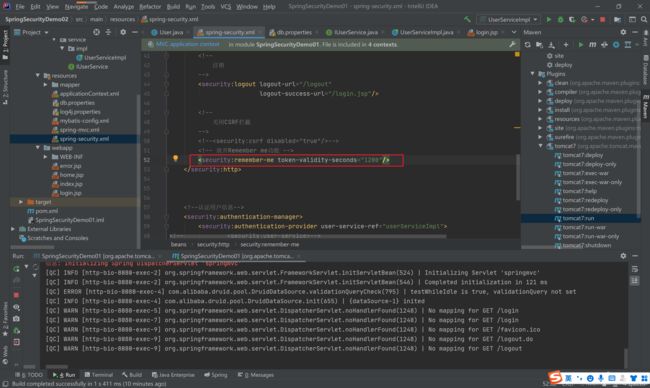
记住我的功能会方便大家的使用,但是安全性却是令人担忧的,因为Cookie信息存储在客户端很容易被人盗取,这时我们可以将这些数据持久化到数据库中。
5.3 持久化记住我
5.3.1 建立一个表
CREATE TABLE `persistent_logins` (
`username` varchar(64) NOT NULL,
`series` varchar(64) NOT NULL,
`token` varchar(64) NOT NULL,
`last_used` timestamp NOT NULL,
PRIMARY KEY (`series`)
) ENGINE=InnoDB DEFAULT CHARSET=utf8
5.3.2 修改配置文件
6.授权
6.1 注解使用
6.1.1 开启注解的支持
在SpringMVC的配置文件中
<beans xmlns="http://www.springframework.org/schema/beans"
xmlns:xsi="http://www.w3.org/2001/XMLSchema-instance"
xmlns:security="http://www.springframework.org/schema/security"
xmlns:context="http://www.springframework.org/schema/context"
xmlns:mvc="http://www.springframework.org/schema/mvc"
xsi:schemaLocation="http://www.springframework.org/schema/beans
http://www.springframework.org/schema/beans/spring-beans.xsd
http://www.springframework.org/schema/security
http://www.springframework.org/schema/security/spring-security.xsd
http://www.springframework.org/schema/context
http://www.springframework.org/schema/context/spring-context.xsd
http://www.springframework.org/schema/mvc
http://www.springframework.org/schema/mvc/spring-mvc.xsd">
<context:component-scan base-package="com.biao.controller">context:component-scan>
<mvc:annotation-driven/>
<security:global-method-security
jsr250-annotations="enabled"
pre-post-annotations="enabled"
secured-annotations="enabled"
/>
beans>
6.1.2 添加依赖
<dependency>
<groupId>javax.annotationgroupId>
<artifactId>jsr250-apiartifactId>
<version>1.0version>
dependency>
6.1.3 控制器通过注解设置
package com.biao.controller;
import org.springframework.stereotype.Controller;
import org.springframework.web.bind.annotation.RequestMapping;
import javax.annotation.security.RolesAllowed;
@Controller
@RequestMapping("/user")
public class UserController {
@RolesAllowed(value = {"ROLE_ADMIN"})
@RequestMapping("/query")
public String query(){
System.out.println("用户查询");
return "/home.jsp";
}
@RolesAllowed(value = {"ROLE_USER"})
@RequestMapping("/save")
public String save(){
System.out.println("用户查询");
return "/home.jsp";
}
@RolesAllowed(value = {"ROLE_USER"})
@RequestMapping("/update")
public String update(){
System.out.println("用户查询");
return "/home.jsp";
}
}
6.1.4 测试
6.1.5 Spring表达式的使用
package com.biao.controller;
import org.springframework.security.access.prepost.PreAuthorize;
import org.springframework.stereotype.Controller;
import org.springframework.web.bind.annotation.RequestMapping;
import javax.annotation.security.RolesAllowed;
@Controller
@RequestMapping("/order")
public class OrderController {
@PreAuthorize(value = "hasAnyRole('ROLE_USER')")
@RequestMapping("/query")
public String query(){
System.out.println("用户查询");
return "/home.jsp";
}
@PreAuthorize(value = "hasAnyRole('ROLE_ADMIN')")
@RequestMapping("/save")
public String save(){
System.out.println("用户查询");
return "/home.jsp";
}
@PreAuthorize(value = "hasAnyRole('ROLE_USER')")
@RequestMapping("/update")
public String update(){
System.out.println("用户查询");
return "/home.jsp";
}
}
6.1.6 SpringSecurity提供的注解
package com.biao.controller;
import org.springframework.security.access.annotation.Secured;
import org.springframework.security.access.prepost.PreAuthorize;
import org.springframework.stereotype.Controller;
import org.springframework.web.bind.annotation.RequestMapping;
@Controller
@RequestMapping("/role")
public class RoleController {
@Secured("ROLE_USER")
@RequestMapping("/query")
public String query(){
System.out.println("用户查询");
return "/home.jsp";
}
@Secured("ROLE_ADMIN")
@RequestMapping("/save")
public String save(){
System.out.println("用户查询");
return "/home.jsp";
}
@Secured("ROLE_USER")
@RequestMapping("/update")
public String update(){
System.out.println("用户查询");
return "/home.jsp";
}
}
6.1.7 异常处理
新增一个错误页面,然后在SpringSecurity的配置文件中配置即可

6.2 标签使用
前面介绍的注解的权限管理可以控制用户是否具有这个操作的权限,但是当用户具有这个权限后进入到具体的操作页面,这时我们还有进行更细粒度的控制,这时注解的方式就不太适用了,这时我们可以通过标签来处理。
<html>
<head>
<title>主页title>
head>
<body>
<h1>欢迎光临h1>
<security:authentication property="principal.username"/>
<security:authorize access="hasAnyRole('ROLE_USER')">
<a href="#">用户查询a>
security:authorize>
<a href="#">用户添加a>
<security:authorize access="hasAnyRole('ROLE_ADMIN')">
<a href="#">用户更新a>
security:authorize>
<security:authorize access="hasAnyRole('ROLE_USER')">
<a href="#">用户删除a>
security:authorize>
body>
html>
